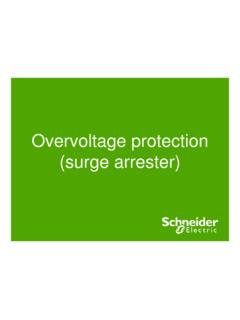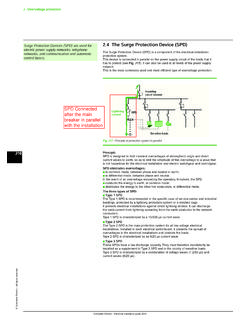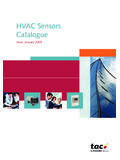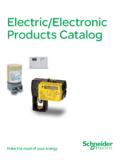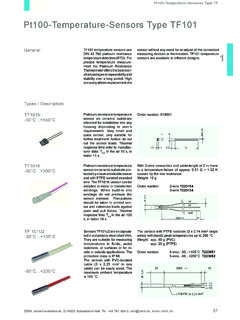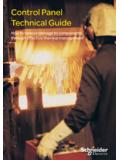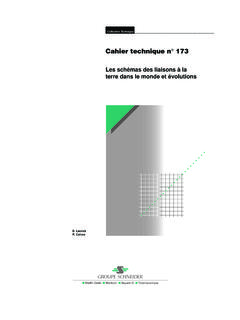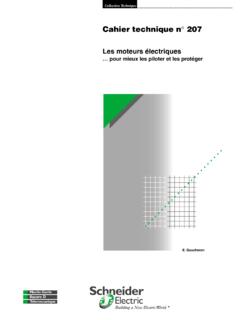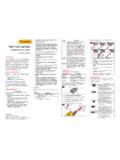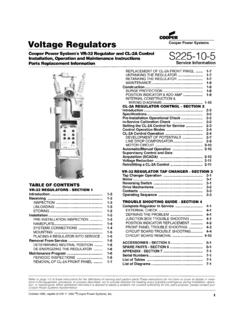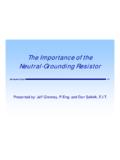Transcription of Medium Voltage technical guide - Schneider Electric
1 Medium Voltage technical guideTe c h n i c a l c o l l e c t i o nBasics for MV cubicle guide is a catalogueof technical know-howintended for Medium voltageequipment Present MV products and equipment and their environment. b Facilitate their choice, according to a normative system of Provide design rules used to calculate the dimensions or characteristics of an MV By proposing simple and clear calculation outlines to guide the designer step by By showing actual calculation By providing information on units of measure and international By comparing some of the main international summaryThis guide helps you to carry out the calculations required to define and determine equipment dimensions and provides useful information enabling you to design your MV Voltage technical Voltage technical guideGeneral contentsPresentation5 Design rules13 Switchgear defi nition47 Units of Voltage technical guidePresentationPrefabricated metal-enclosed switchgear 6 Introduction 6 Voltage
2 6 Current 8 Frequency 9 Switchgear functions 9 Accessibility and service continuity metal-enclosed switchgearIntroductionIn order to design a Medium - Voltage cubicle, you need to know the following basic magnitudes: VoltageCurrentFrequencyShort-circuit Voltage , the rated current and the rated frequency are often known or can easily be defined, but how can we calculate the short-circuit power or the short-circuit current at a given point in an installation?Knowing the short-circuit power of the network allows us to choose the various parts of a switchboard which must withstand significant temperature rises and electrodynamic constraints. Knowing the Voltage (kV) will allow us to define the dielectric withstand of the : circuit breakers, insulators, , control and protection of electrical networks are achieved by using classification of metal-enclosed switchgear is defined in the IEC standard 62271-200 with a functional approach, using several to compartments by personsLevel of Loss of Service Continuity when a main circuit compartment is openedType of metallic or insulated barriers, between live parts and opened accessible compartmentLevel of internal arc withstand in normal operating Voltage U (kV)It is applied across the equipment is the network Voltage where the equipment is Voltage Ur (kV)This is the maximum r ms (root mean square) value of the Voltage that the equipment can withstand under normal operating conditions.
3 The rated Voltage is always higher than the operating Voltage and, is associated with an insulation level Ud (kV r ms 1 min) and Up (kV peak)This defines the dielectric withstand of equipment to power frequencyovervoltages and lightning : overvoltages of internal origin, accompany all changes in the circuit: opening or closing a circuit, breakdown or shorting across an insulator, is simulated in a laboratory by the rated power-frequency withstandvoltage for one : overvoltages of external origin or atmospheric origin occur whenlightning falls on or near a line. The Voltage wave that results is simulated in a laboratory and is called the rated lightning impulse withstand : IEC 62271-1, article 4 sets the various Voltage values together with, in article 6,the dielectric testing start with, here is some keyinformation on MV switchboards!reference is made to the InternationalElectrotechnical Commission (IEC).
4 Example:Operating Voltage : 20 kVRated Voltage : 24 kVPower frequency withstand Voltage 50 Hz 1 min: 50 kV r msImpulse withstand s: 125 kV metal-enclosed switchgearStandardsApart from special cases, Schneider Electric equipment are compliant with tables 1a and 1b of IEC standard 62271-1 common lightning impulse withstand s 50 HzRated power-frequency withstand voltageNormal operating voltagekV r mskV peak1 min kV r mskV r msList 1 List to to to 1524951255020 to to 36 The values of withstand voltages in the tables are considered for normal services conditions at altitudes of less than 1000 metres, 20 C, 11 g/m3 humidity and a pressure of kPa. For other conditions, correction factors are applied for the test and in some cases, derating has to be insulation level corresponds to a distance in air which guarantees equipment withstand without a test impulse withstand voltageDistance/earth in air cmkV r standardised voltagesDE59002 ENRated lightningwithstand s50 voltageUdUrUpRated power frequencywithstand voltage50 Hz 1 metal-enclosed switchgearCurrentRated normal current: Ir (A)This is the r ms value of current that equipment can withstand when permanently closed, without exceeding the temperature rise allowed in table below gives the temperature rises authorised by the IEC 62271-1 according to the type of normal current:Type of mechanism of materialMax.
5 ValuesMax. temperature of conductor ( C)Max. temp. rise = t . max. 40 CContacts in airBare copper or copper alloy7535 Silver or nickel plated10565 Tin-plated9050 Bolted connections or equivalent devices in airBare copper, bare copper alloy or aluminium alloy9050 Silver or nickel : rated currents usually used by Schneider Electric are: 400, 630, 1250, 2500 and 3150 short-time withstand current: Ik (A)This is the rms value of the current which the switchgear can carry in the closed position during a specified short time. Short time is generally 1 s, and sometimes 3 peak withstand current: Ip (A)This is the peak current associated with the first major loop of the rated short-time withstand current which the switchgear can carry in the closed current: I (A)This is calculated from the consumption of the devices connected to the considered circuit. It is the current that really flows through the equipment.
6 If we do not have the information to calculate it, the customer has to provide us with its value. The operating current can be calculated when we know the power of the current :For a switchboard with a 630 kW motor feeder and a 1250 kVA transformer feeder at kV operating the operating current of the transformer feeder:Apparent power:bvcalculating the operating current of the motor feeder:cos = power factor = = motor efficiency = = = = 82 cos S = UI3I = = = 130 metal-enclosed switchgearMinimal short-circuit current: Isc min (kA r ms) of an electrical installation(see explanation in Short-circuit currents chapter.)R ms value of maximal short-circuit current: Ith (kA r ms 1 s or 3 s) of an electrical installation(see explanation in Short-circuit currents chapter.)
7 Peak value of maximal short-circuit: Idyn (kA peak) of an electrical installation(value of the initial peak in the transient period)(see explanation in Short-circuit currents chapter.)Frequency fr (Hz)Two frequencies are usually used throughout the world: 50 Hz in Europe60 Hz in countries use both frequencies functionsDesignation and symbolFunctionCurrent switchingOperating currentFault current DisconnectorIsolatesEarthing disconnectorConnects to the earth(short-circuit making capacity)SwitchSwitchesbDisconnector switchSwitchesIsolatesbFixed circuit breakerSwitchesProtectsbbWithdrawable circuit breakerSwitchesProtectsIsolates if withdrawnbbFixed contactorSwitchesbWithdrawable contactorSwitchesIsolates if withdrawnbFuseProtectsdoes not isolateb (once)b = metal-enclosed switchgearAccessibility and service continuity Some parts of a switchgear may be made accessible for the user, for various reasons from operation to maintenance, and such an access could impair the overall operation of the switchgear then decreasing the IEC 62271-200 proposes user-oriented definitions and classifications intended to describe how a given switchgear can be accessed, and what will be the consequences on the manufacturer shall state which are the parts of the switchgear which can be accessed, if any, and how safety is ensured.
8 For that matter, compartments have to be defined, and some of them are going to be said categories of accessible compartments are proposed:Interlock based access: the interlocking features of the switchboard ensure that the opening is only possible under safe conditionsProcedure based access: the access is secured by means of, for instance, a padlock and the operator shall apply proper procedures to ensure a safe accessTool based access: if any tool is needed to open a compartment, the operator shall be aware that no provision is made to ensure a safe opening, and that proper procedures shall be applied. This category is restricted to compartments where no normal operation nor maintenance is the accessibility of the various compartments are known, then the consequences of opening a compartment on the operation of the installation can be assessed; it is the idea of Loss of Service Continuity which leads to the LSC classification proposed by the IEC: category defining the possibility to keep other high- Voltage compartments and/or functional units energised when opening a accessible high- Voltage compartment.
9 If no accessible compartment is provided, then the LSC classification does not categories are defined, according to the extent to which the switchgear and controlgear are intended to remain operational in case access to a high- Voltage compartment is provided :If any other functional unit than the one under intervention has to be switched off, then service is partial only: LSC1If at least one set of busbars can remain live, and all other functional units can stay in service, then service is optimal: LSC2If within a single functional unit, other(s) compartment(s) than the connection compartment is accessible, then suffix A or B can be used with classification LSC2 to distinguish whether the cables shall be dead or not when accessing this other is there a good reason for requesting access to a given function? That s a key metal-enclosed switchgearPE57700 Example 1:Here is a GIS solution with in (D) what is said to be Base section with cable connection area (AREVA WI).
10 There is no connection compartment, and the only HV compartments are gas , there is no accessible compartment to be considered for LSC classification. LSC is not relevant in that case, and service continuity during normal operation and maintenance is expected to be 2:Here is a GIS solution ( Schneider Electric CGset) with an air insulated connection (and possibly VT) compartment. This compartment is accessible (with tools).The other HV compartments are not to the connection compartment is possible with the busbar(s) live, meaning all other functional units can be kept LSC classification applies, and such solution is 3:Here is a GIS solution ( Schneider Electric GMset) with an air insulated connection (and possibly VT) compartment. This compartment is accessible and interlocked with the earthing circuit breaker can be extracted (tool access compartment), even if that is not considered as normal operation nor normal to one functional unit within a switchboard does not require any other functional unit to be switched off.
